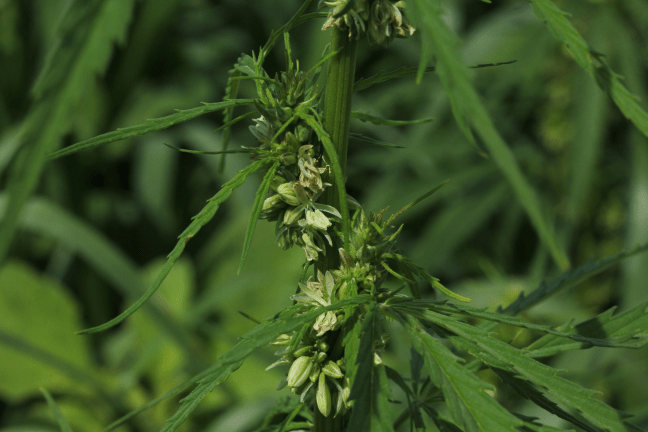Hemp is an incredible plant that can be processed into many different products. While most production in the U.S. has focused on cannabinoids, the industry has shown a growing interest in producing hemp for grain or fiber. However, there is another option: to produce hemp for both the grain and fiber with a dual-purpose crop.
Why grow a dual-purpose hemp crop? It means multiple streams of income for a grower from one crop and making full use of the hemp plant. This also provides security for a grower in case prices are low for either the grain or fiber.
While dual-purpose hemp can also be grown for fiber and cannabinoids, this type of production is newer and less common for hemp producers worldwide. Triple-purpose hemp is also another option, but it has not gained popularity like grain and fiber dual-purpose production because of the glut of high-quality cannabinoid hemp already available for processing in the U.S. Grain and fiber have become the primary targets for dual-purpose hemp in European countries where these markets are more developed.
Dual-purpose production has not yet gained popularity in the U.S. Some important changes need to take place before that can happen. First, both the grain and fiber markets need to develop more across the country. The appropriate harvesting equipment and processing infrastructure also need to become more accessible. It is a chicken-or-the-egg scenario, though: Markets can’t fully develop without infrastructure and equipment in place, but getting that to happen requires the industry to develop.
This will not happen overnight, but it is gradually taking place. (Some industry experts expect the market to evolve within the next 10 years.) And we already know farmers are willing and able to produce hemp based on the increase in licensed growers and acreage immediately after the Agriculture Improvement Act of 2018 (the 2018 Farm Bill) was signed.
Dual-Purpose Hemp Genetics
The European hemp industry has led the way in researching production and genetics for grain and fiber dual-purpose hemp. Breeders (notably Colorado-based New West Genetics) are now working on developing hemp varieties specifically for dual-cropping.
A hemp crop that maintains the quality of fiber while the seeds mature is a desirable trait for dual systems. Hemp that exhibits this trait is often monecious, which means both male and female flowers are present on the same plant.
Typically, hemp is dioecious, which is problematic when the seeds and fiber are to be harvested. Male plants senesce (degenerate) shortly after pollination, reducing the plant population and fiber yields when harvest occurs later in the season. That makes dioecious plants less desirable for dual-purpose systems.
A long vegetative state is also ideal for dual-purpose hemp. This crop gains most of its height during the vegetative period, so cultivars that flower early are not going to grow as tall as those that flower later in the season. Taller hemp is ideal for fiber production.
Because most of the breeding efforts of monecious hemp for dual purpose has occurred in Europe, some of the cultivars may not be suited for certain U.S. regions. Many universities around the world are conducting trials that include European, Asian and Canadian hemp cultivars to find which perform best. Performance studies look at the suitability of cultivars to a new region or area. Latitude and climate can influence how well a cultivar grows, its susceptibility to different pests, and what the final yields are. Ideally, a hemp cultivar that is from a similar latitude and climate region as the trial site will perform similarly to where it was originally bred.
The Economics of Dual-Purpose Hemp Production
Prospective dual-purpose growers will want to look at the economics of production. Hemp grown specifically for grain or for fiber will likely return higher yields compared to dual-purpose hemp; however, that may not translate to higher returns.
In 2015, extension specialists at Colorado State University assessed returns for fiber-only, grain-only and dual-purpose hemp production systems. They found that while a dual system yielded lower returns than a grain-only system, the dual system did provide greater returns than a fiber-only system.
In a more recent (2020) production evaluation, a specialist at Cornell University found that a dual-purpose system had higher returns than both grain- and fiber-only models. Dual-purpose production yielded nearly $898.40 per acre, while an acre of fiber production yielded $635.20 and an acre of grain production yielded $700 in gross returns. Variable input costs are similar across all three models.
In another 2020 study, which examined the potential of hemp’s use in biofuel, University of Kentucky researchers also found that dual-purpose hemp held a higher economic value than fiber-only varieties because of its additional grain yield.
However, no matter what the production system is, variable costs will differ from farm to farm, and returns will depend on the value of the stalk and seed, which vary based on location and quality.
Equipment for Growers
Growers pursuing dual-purpose crop production would benefit from equipment that can harvest all portions of the hemp plant at once. This equipment, called a double cut combine, does exist. Its top header cuts the upper portion of the plant and harvests the grain or female flowers, while a lower mower cuts and lays the stalks on the ground.
However, this equipment is costly. Right now, the most sophisticated harvesting equipment comes from Europe, which also means high shipping costs. Costs of dual-purpose harvesting equipment will likely decrease as more manufacturers begin to jump on board.
Without the use of this specialized equipment, dual-purpose growers need to harvest the grain with a combine and then go through and cut the stalks separately. Most farmers interested in grain or fiber production already either own or have access to this harvesting equipment. But traditional combines have drawbacks too—using them takes more time than working with a double cut combine. Also, driving equipment on the field too much can increase soil compaction and use additional fuel.
Processing Infrastructure
Growers considering dual-purpose hemp also should make sure they have the necessary processing infrastructure nearby.
Hemp grain’s value may justify shipping it off to a processing facility further away. However, the price of stalk material is not as high per pound, and tons of baled stalk material would incur high freight costs. Processing equipment to perform the initial decortication of the stalk and equipment for further fiber refinement or final product manufacturing would ideally be near each other.
As more products are developed from hemp, more processing infrastructure will follow. There are so many applications outside of textiles and food, like plastics, composites and building materials. In the future, regional hubs will likely specialize in different types of product manufacturing. In fact, hubs like these are already forming; for example, hemp growers in southeastern Indiana have joined to form the Heartland Hemp Cooperative to process their own fiber.
A dual-purpose hemp crop is likely to increase in popularity as the grain and fiber markets develop in the U.S. and globally. With so much interest in using all parts of the hemp plant, as well as an increasing number of growers who have experience producing hemp for grain and fiber, dual-purpose production will be a feasible option in the coming years.

